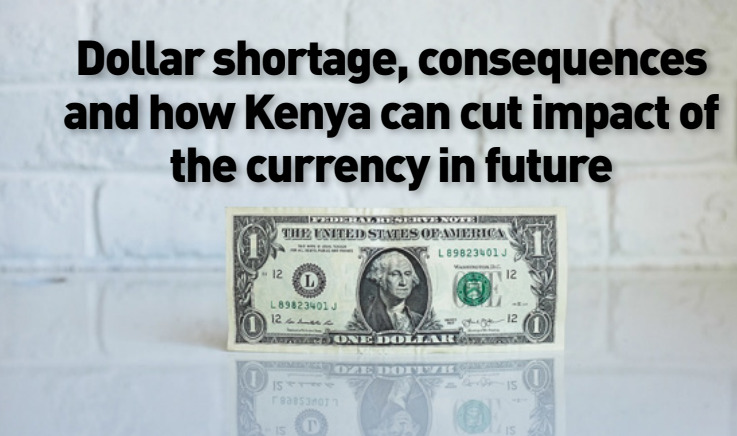Dollar shortage, consequences and how Kenya can cut impact of the currency in future

Kenya has been facing a dollar shortage since March last year. This is an acute foreign exchange crunch, with the US dollar reserves dropping to their lowest in eight years. The Kenyan currency keeps plummeting against major global currencies and according to the Central Bank of Kenya (CBK), the plunge of the Kenyan shilling has been so substantial that it has even breached the regional reserves policy.
Causes of the Dollar shortage in Kenya
There have been several causes of the dollar shortage in Kenya. Some experts assert that the Kenyan currency hasn’t recovered from the global economic crisis sparked by the Covid-19 pandemic which stifled the country’s key exports thereby cutting its dollar inflows. These were heightened by other issues thereafter such as continued drought, and the Russian invasion of Ukraine which triggered a hike in fuel prices and rising inflation.
Analysts are also blaming a CBK directive to commercial banks in the country to begin rationing dollar sales to manufacturers, importers and others in need of the hard currency. As expected, the banks complied immediately, limiting daily dollar transactions to USD 5,000.
Additionally, the US Federal Reserve hiked interest rates at a record pace, tackling US inflation that was spiking due to global fuel and food price rises post the Russian invasion of Ukraine. Consequently, the value of the Kenyan Shilling dropped and this has contributed to the ongoing shortage as it became more expensive to buy the dollar.
Consequences of the dollar shortage
The East Africa Community (EAC) forex reserves policy specifies that a member country must have in its coffers at least four months’ worth of forex reserves in terms of imports cover at any given time. Kenya’s reserves have been below the required levels since January 26.
This dip, to a significant extent, is attributed to the repayment of loans to bilateral and commercial lenders, as well as CBK’s efforts to check the downward spiral of the shilling against the US dollar. As at March 7, the shilling was trading at 127.80 against the US dollar from KSh 125.6 in mid-February. It has lost 27% of its value since February 2020.
Foreign investors are shying away from Kenya’s capital markets due to a lack of adequate foreign exchange to invest in securities at the Nairobi bourse and repatriate accrued dividends and returns. Reduced activity by foreigners will hurt capital inflow besides fees and commissions charged by stockbrokers and the bourse operators.
US lender JP Morgan on March 22 last year issued a client alert on Kenya saying that it was straining to complete some client transactions in Kenya due to dollar liquidity constraints.
The Kenya Association of Manufacturers (KAM) has stated that many manufacturers and processors are now struggling to do business due to the scarcity of dollars in commercial banks which they use to source raw materials in foreign markets.
Importers blame the panic purchase of dollars from banks and forex bureaus on an increased cost of doing business and have been crossing the border to Tanzanian commercial banks to source for US dollars. In the meantime, Kenya’s Treasury has blamed manufacturers for hoarding dollars. Kenyans are crossing to Tanzania in search of US dollars.
The rise of the US dollar black market
The demand for dollars is highest among importers. While the CBK rate is currently 127.80, the black market rate is as high as 139. Some listed companies have resorted to trading US dollars among themselves, in turn breaking the CBK law and causing the emergence of parallel exchange rates, resulting in lenders buying and selling well above the printed official CBK rate.
How Kenya can cut the impact of the US dollar in future
Kenya has an ambitious programme to introduce a repo market in 2023, backed by a local Central Securities Depository. Repurchase Agreements (Repo) are conducted whenever the Central Bank is mopping up excess liquidity from the domestic market. A repo is a collateralized loan involving a contractual arrangement between two parties, whereby one party sells a security at a specified price with a commitment to buy back the same at a later date. The repo rate is the interest paid by the Central Bank to Commercial Banks for lending money in the repo market. This should improve liquidity in the underlying bonds, cheapening the level it can issue local currency debt.

